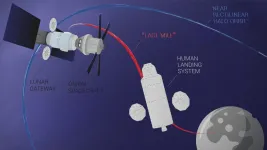(Press-News.org) Researchers from Skoltech and the Massachusetts Institute of Technology have analyzed several dozen options to pick the best one in terms of performance and costs for the 'last mile' of a future mission to the Moon - actually delivering astronauts to the lunar surface and back up to the safety of the orbiting lunar station. The paper was published in the journal Acta Astronautica.
Ever since December 1972, when the crew of Apollo 17 left the lunar surface, humans have been eager to return to the Moon. In 2017, the US government launched the Artemis program, which intends to bring "the first woman and the next man" to the lunar south pole by 2024. The Artemis mission will use a new orbital platform, dubbed the Lunar Gateway, which is going to be a permanent space station from which reusable modules will bring astronauts back to the Moon. This new approach requires a reanalysis of the optimal landing approaches; the private companies contracted by NASA to design the reusable landing modules are conducting this research, but keeping their findings to themselves.
Skoltech M.Sc. student Kir Latyshev, Ph.D. student Nicola Garzaniti, Associate Professor Alessandro Golkar, and MIT's Edward Crawley developed mathematical models to assess the most promising options for human landing systems for a future Artemis mission. For instance, the Apollo program used 2-stage architecture, when the Apollo Lunar Module, consisting of a descent and ascent modules, was able to carry two people to the lunar surface and back up, leaving the descent module behind.
The team assumed the Lunar Gateway is located in the L2 near rectilinear halo orbit, the currently preferred option that has the station orbiting the L2 Lagrange point in a way that makes it easier to land on the lunar south pole. They also modeled an expedition of four astronauts, who will spend around seven days on the Moon. The scientists considered both the optimal number of stages and the preferred propellants for the system. In total, they went through 39 variants of the future lunar human landing system, also modeling the cost for the most promising options.
The team went through a comprehensive approach for assessing alternative concepts of lunar human landers, looking at a broad number of options using architectural screening models. They first defined the key set of architectural decisions to be taken, such as number of stages and propellant type to be employed at each stage of the lander. They organized the information in mathematical models, and performed a comprehensive computational exploration of alternative system architectures coming from the combination of the different architectural decisions. Finally, they analyzed the resulting tradespace and identified preferred architectures for consideration by stakeholders concerned with the design of human lunar landers.
Their analysis showed that for expendable landing systems such as the ones used in the Apollo program, the 2-stage architecture is indeed the most advantageous as it has both lower total dry masses and propellant loads as well as lower launch costs per mission. However, for reusable vehicles planned for the Artemis program, 1-stage and 3-stage systems quickly become comparable in their advantages.
With all assumptions in the paper considered, the 'ultimate' winner for a number of short 'sortie'-type lunar missions is the 1-stage reusable module running on liquid oxygen and liquid hydrogen (LOX/LH2). The authors note that this is a preliminary analysis, which does not take into account crew safety, probability of mission success as well as project management risks considerations - these will require more elaborate modeling at a later stage of the program.
Kir Latyshev notes that, for the Apollo program, NASA engineers did a similar analysis and chose the 2-stage lunar module. However, the overall architecture of lunar missions was different back then. It did not have an orbiting lunar station to keep the lunar module at between the missions, which meant that all ALM flights should be performed directly from Earth. It also meant using fully expendable lunar modules (a new vehicle for each mission), as opposed to reusable ones considered nowadays. Apart from that, without the lunar station, one of the current options - the 3-stage landing system - was not possible at all.
"Interestingly, our study finds that, even with the orbiting station, if fully expendable vehicles are considered, then the 2-stage (Apollo-like) landing system is still expected to have lower masses and, therefore, lower costs - which sort of reconfirms the Apollo decision. However, reusability changes that. Though 1-stage and 3-stage vehicles in this case are still heavier than the 2-stage one, they allow to reuse more of the 'vehicle mass' (approximately 70-100% compared to around 60% for the 2-stage option) over and over again, thus saving money on producing and delivering new vehicles to the orbiting station and making lunar missions potentially cheaper," Latyshev says.
He adds that crew safety consideration is an important factor in designing human space systems which the authors did not account for in their study. "This safety factor can affect the results in either way. For example, multi-stage solutions might offer more safe return opportunities in case of emergency in the parking lunar orbit prior to descent to the surface than our 'winner', the 1-stage system: either the descent or ascent vehicle can be used for return in case of 3-stage and 2-stage systems as opposed to the single stage of the 1-stage system. At the same time, 2-stage and 3-stage systems are expected to be more complex and therefore to have more risks of breakdowns, as opposed to the simpler 1-stage solution. So there is a trade-off again," Latyshev explains.
The team plans to expand the work in the future, with a comprehensive exploration of the system architecture of the entire exploration infrastructure required in future human spaceflight programs for lunar exploration.
INFORMATION:
An RCSI study conducted in Beaumont Hospital in Dublin has found that surgery, rather than antibiotics-only, should remain as the mainstay of treatment for acute uncomplicated appendicitis.
Published in the Annals of Surgery and led by researchers from the RCSI University of Medicine and Health Sciences, the study entitled the COMMA trial (Conservative versus Open Management of Acute uncomplicated Appendicitis) examined the efficacy and quality of life associated with antibiotic-only treatment of acute uncomplicated appendicitis versus surgical intervention. The results revealed that antibiotic-only treatment resulted in high recurrence rates and an inferior quality ...
Drugs such as beta-adrenergic antagonists (beta blockers) have been linked to a range of adverse effects, including depression. But how reliable are these data, and which psychiatric side effects might indeed be caused by these drugs? These questions have been addressed by a team of researchers from Charité - Universitätsmedizin Berlin, whose comprehensive meta-analysis has been published in Hypertension*. While treatment with beta blockers was not found to be associated with an increased incidence of depression, some studies recorded higher levels of sleep disturbance.
Beta-adrenergic ...
During the past decade the European People's Party in the European Parliament was criticized for its unwillingness to vote for measures that would sanction the Hungarian Fidesz government, which is accused of breaching key democratic principles.
Researchers have said the EPP protected Fidesz in order to safeguard Hungarian votes in its ranks and protect their own interests, but this support had weakened by 2019, when Fidesz was suspended from the EPP.
Researchers analysed the votes of EPP MEPs for 24 resolutions covering the protection of EU fundamental values ...
(Boston)-- Warning signs for Alzheimer's disease (AD) can begin in the brain years before the first symptoms appear. Spotting these clues may allow for lifestyle changes that could possibly delay the disease's destruction of the brain.
"Improving the diagnostic accuracy of Alzheimer's disease is an important clinical goal. If we are able to increase the diagnostic accuracy of the models in ways that can leverage existing data such as MRI scans, then that can be hugely beneficial," explained corresponding author Vijaya B. Kolachalama, PhD, assistant professor of medicine at Boston University School ...
COLUMBUS, Ohio - An analysis of historic and projected simulations from 19 global climate models shows that, because of climate change, the temperature in the Antarctic peninsula will increase by 0.5 to 1.5 degrees Celsius by 2044.
The projections also showed that precipitation - a threat to ice if it manifests as rain - will likely increase on the peninsula by about 5% to 10% over that same time period.
The estimates were published recently in the journal Climate Dynamics.
"We are concerned about these findings. We've been seeing overall quite big changes on the peninsula, generally getting warmer and ice shelves and glaciers discharging into the ocean," said David Bromwich, a leading author of the study and a research professor at The Ohio State University ...
PROVIDENCE, R.I. [Brown University] -- Proposals to create a national gun registry have long been met with fierce opposition from gun rights advocates. While proponents say a registry would help in tracking guns used in crimes, opponents worry that it would compromise privacy and could be used by the federal government to confiscate firearms. Now, a team of Brown University computer scientists has devised a way of implementing a registry that may allay some of those concerns.
They propose a database that uses advanced encryption to protect privacy. The encryption scheme allows the database to be searched without being decrypted, which means people querying the database see only the records they're looking for and nothing else. Meanwhile, the system places control of data ...
Lemurs can use their sense of smell to locate fruit hidden more than 50 feet away in the forest--but only when the wind blows the fruit's aroma toward them, according to a study published in the American Journal of Physical Anthropology.
"This is the first time research has demonstrated that primates can track a distant smell carried by the wind," said anthropologist Elena Cunningham, a clinical associate professor of molecular pathobiology at NYU College of Dentistry and the study's lead author.
Many animals use their sense of smell to locate food. However, less is known about whether primates can smell food that is far away, or if they instead rely on visual cues or memory to find their next meal.
Because many primates--including ring-tailed lemurs, ...
CORVALLIS, Ore. - Oregon State University researchers analyzed more than 17,000 public comments focused on orca conservation in the state of Washington and found that the most common emotional sentiments were trust, anticipation and fear.
The recently published findings have important implications because they provide conservation managers a way to convert a large volume of information to a manageable amount that can help them understand why people might support or reject management actions, the researchers said.
"Emotions are intertwined in our decision-making, often playing a substantive role in public evaluations of conservation policies," said Kelly Biedenweg, an author ...
(Portland - March 15) Results of a clinical study conducted by researchers in Manaus, Brazil, show that the Gazelle® Malaria test outperformed Rapid Diagnostic Tests (RDTs) and was nearly as accurate as more expensive and time-consuming expert microscopy in detecting Plasmodium vivax (P. vivax) malaria. The data was published Friday, March 12 in the Malaria Journal.
The double-blind study was based on 300 participants who sought care from Fundac?a?o de Medicina Tropical Doutor Heitor Vieira Dourado (FMT-HVD), located in Manaus, an area in the Western Brazilian Amazon, heavily endemic for P. vivax.
"Because P. vivax is not adequately detected by current tests, the infection is frequently missed, and patients don't receive essential treatment," said ...
Copper nanomaterials with a cubic shape so perfect that they form neatly aligned stacks when brought together have been created by researchers at KAUST. The cuboid copper nanoclusters, developed by rational design, are a new member of an exotic nanomaterial family that has shown many promising properties but has remained very hard to make.
"Copper nanomaterials are a class of materials that exhibit useful properties for the fields of photoluminescence and catalysis," says Ren-Wu Huang, a postdoc in Osman Bakr's lab, who led the research. There is great interest in synthesizing new copper nanomaterials to understand how their structure influences their function.
Copper nanoclusters, which are of an atomically precise structure, are among the few copper nanomaterials that ...




